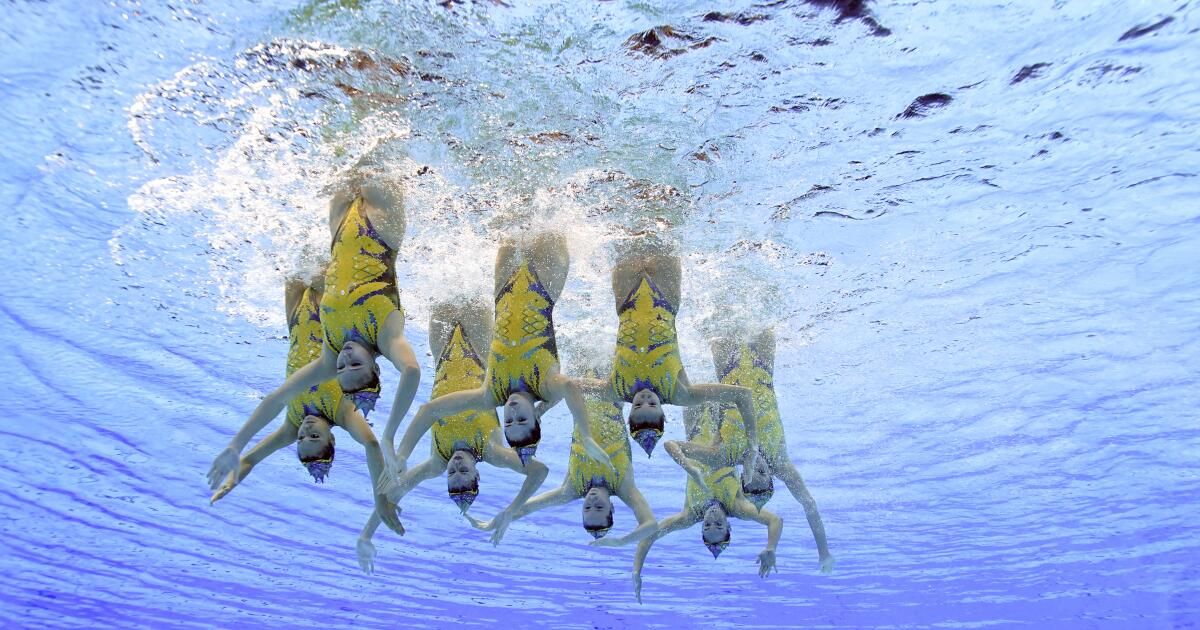Book Review
Swimming Pretty: The untold story of women in the water
By Vicki Valosik
Live Law: 432 pages, $28.99
If you buy books linked to on our site, The Times may earn a commission from Bookshop.org, whose fees support independent bookstores.
When I was little, my mother used to take me with me when she taught physical education at a small women's college, run by nuns who were happy to have a young married woman to take care of fencing instruction and sex education. Mom also taught swimming lessons, teaching the basics along with American Red Cross certified lifeguards.
My favorite days at the pool were the ones when Mom reminded the students that there was more to swimming than laps; It also involved strength and acrobatics. She would demonstrate some “synchronized” moves herself (she was by no means an expert, but she was young and brave) before asking the class to try it. After failing, they filled the chlorine-smelling room with laughter.
Journalist Vicki Valosik, a synchronized swimming expert, knows that the sport involves more than waterproof makeup and sequined suits. Her new book, “Swimming Pretty: The Untold Story of Women in Water,” traces the history of the sport with the precision and grace of an Esther Williams painting (more on Williams shortly). The author shows how the different facets involved in aquatic feats allowed women competitive sporting opportunities that they could not find anywhere else.

Vicki Valosik, author of “Swimming Pretty.”
(Khair EIZarrad)
Since Candy Costie and Tracie Ruiz's fantastic gold medal win at the 1984 Los Angeles Olympics, not to mention innovations both in and out of the water such as rigorous training and technical standards, interest in synchronized swimming is strong. . However, many people still don't understand how the sport developed, not to mention how difficult it is to perfect moves like the upright, in which a swimmer maintains a perfect ballet posture face down in the water.
The modern approach to swimming began during the Renaissance, when a Frenchman named Melchisédech Thévenot wrote a book on the subject, closely followed by the Englishman Everard Digby, whose 1587 “De Arte Natandi” (“The Art of Swimming”) described not only ways of moving through the water, but also some types of acrobatics or “refinements”. Valosik delights in opening his section on the “Science” of swimming with descriptions of a young Benjamin Franklin practicing “scientific swimming.” He and other advocates of water sports believed that regular swimming and water exercises were the best exercise for health and figure.
Given that approach, one might think that men would have encouraged women to jump. However, given the centuries during which water tests were used to prove witchcraft, not to mention the ridiculous lengths to which authorities would go to keep women's figures covered, Every time those women approached a beach, Society frowned. As Valosik points out, for a long time it seemed like swimming was a man's thing; women would have to be content with bathing.
However, in the “Scenario” chapter, Valosik shows that several intrepid women, notably the Beckwith sisters of 19th-century England and “Lurline the Water Queen” of the United States, used the public obsession with the female physique to launch their careers. Agnes Beckwith became the first woman to swim from London to Greenwich, wearing a swimsuit woven from “pink” llama wool. Lurline's tank-based stunts, which showcased her 200-cubic-inch lung capacity, were taken further by the “mother of synchronized swimming,” Annette Kellerman. Kellerman's fame and fortune grew as he made blockbuster films such as “Neptune's Daughter” (1914) and “Daughter of the Gods” (1916), in which Kellerman jumped from a 100-foot tower into the waters of San Francisco Bay, avoiding rocks. at the base by only 3 feet.
Such famous women in the water sparked a real craze for swimming lessons, especially after the 1904 tragedy of a fire aboard the New York Harbor steamer General Slocum. More than 1,000 people, mostly women and children who were on a church transept, died when they tried to escape the flames and drowned. Few of them knew how to swim, and even those who could were hampered by heavy clothing and shoes. “Safety,” as Chapter 4 is titled, was added to the art of swimming before it could become Chapter 5, “Sport.”
Enter American Gertrude Ederle, the first woman to swim the English Channel, whose natural athleticism highlighted an era in which women finally broke down some of the barriers between bathing and swimming. During the 1930s, “synchronization” (as it was first called) combined water resistance with water acrobatics, when innovators such as Katherine Curtis developed signature moves that, when performed by swimmers linked at the arms, legs or both, could create dazzling patterns. . Chapter 8, “Spectacle,” follows the discovery and triumphs of actress and swimmer Esther Williams in 1939. It is she who gives the book its title, having once said: “If you're not strong enough to swim fast, you probably won't. be strong enough to swim 'nice'.”
Williams made a name for himself in the “Aquacade” shows, which he called “a sexual carnival” and which he left for… Hollywood. Her films caused, of course, a great stir.
In 1984, when synchronized swimming debuted as an Olympic sport at the Los Angeles Summer Games, Williams said, “Imagine having the lung power of a distance runner, the leg strength of a water polo player to accomplish those lifts.” . out of the water, the grace and rhythm of a ballet dancer working to music, a gymnast performing a full floor exercise underwater while holding her breath. …And then you add to that that she must do all of this in perfect synchronization with her partner, and that is synchronized swimming.”
This sport, now officially called “artistic swimming,” has become more difficult. Women have broken more barriers to proper training and recognition; Today, “synchronization” poses new security risks as competitors become stronger, faster and fiercer. But even when my mother's students laughed because they couldn't hold the positions required for “synchronization,” none of them wanted to stop trying. Once you put women in the water, they will never sit pretty on the shore again. When the 2024 Games begin next month in Paris, “Swimming Pretty” can be a great introduction to a spectacular and grueling sport.
Bethanne Patrick is a book reviewer, podcast host, and author of the memoir “life b“Overcoming double depression.”











